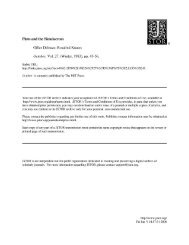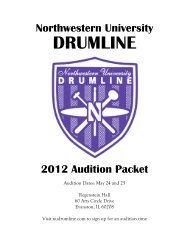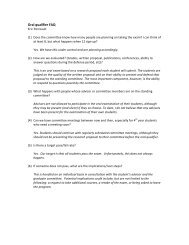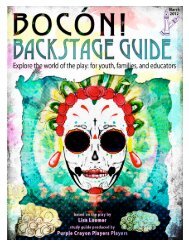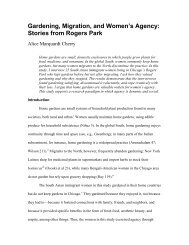research - Associated Student Government, Northwestern University
research - Associated Student Government, Northwestern University
research - Associated Student Government, Northwestern University
Create successful ePaper yourself
Turn your PDF publications into a flip-book with our unique Google optimized e-Paper software.
RESEARCHwas air/ And playing, lovely and watery/ And fire greenas grass” (19-22). Indeed the speaker’s description of thenatural scene around him does seem to be “running.”He describes the different components of the scene,such as the sun, hay fields, and air through enjambedstaccato verses of primarily monosyllabic syllables, anduses the connective “and” frequently to link verses, asopposed to adopting more marked pauses (i.e. a comma,semicolon, or period).As the poem progresses, symbolizing the passageof time, Thomas’s tone shifts drastically. In retrospect,Thomas’s speaker realizes death’s presence and duplicity,as he writes, “Time let me play and be/ Golden in themercy of his means” (13-14). Although death disguiseditself through a seemingly generous time that granted“mercy” during his youth, Thomas is now fully awarethat the mercy was only temporary, for every day of hismajestic youth moved him one step closer to death:And nothing I cared, at my sky blue trades, that time allowsIn all his tuneful turning so few and such morning songsBefore the children green and goldenFollow him out of grace.Nothing I cared in the lamb white days, that time would take meUp to the swallow thronged loft by the shadow of my hand,In the moon that is always rising,Nor that I riding to sleepI should hear him fly with the high fieldsAnd wake to the farm forever fled from the childless land. (42-51, emphasis added)The scene portrayed here epitomizes Thomas’s realizationof the ominous nature of death. His discovery offalling “out of grace” is incredibly disturbing and exemplifieshis conception of death as a merciless “destroyer.”The speaker’s portrayal of death verges on that of aseductress, leading him unknowingly to the “swallowthronged loft.” Alas, the days of his youth have passed alltoo quickly, and the speaker now finds himself trappedin the grudgingly lonely days of adulthood.The speaker at this point is now an old man, anxiouslyawaiting death. Though death managed to foolhim during his younger days, he is now fully aware oflife’s paradoxical nature: “Oh as I was young and easyin the mercy of his means, / Time held me green anddying/ Though I sang in my chains like the sea” (52-54).The speaker acknowledges the limitations that time imposesbecause he perceives death as a fixed and absoluteend. Though time once held him “green,” he realizesnow that it simultaneously holds him “dying,” for itsprogression moves incessantly toward the end of humanexistence.Romantic writers, though expressing a similar lamentin response to the initial pain of death, neverthelessfelt themselves able to transcend the boundaries ofmortality. The speaker in “A Slumber Did My Spirit Seal”observes that through the young girl’s unity with EternalNature, she in effect becomes eternal herself. Shelley’sspeaker remarks that Keats’s death actually brings abouta more-elevated form of existence through his being rememberedby countless generations thereafter. Thomas,however, resists all such reappraisal. At the end of hispoem, though he finds himself “singing,” fighting withall of his might against inevitable death, he admits thathe is ultimately in “chains,” forever bound to the fixedmaterial fate that time has given him.5. ConclusionAlthough modern criticism regularly analyzesThomas’s work relative to the inspiration he drew fromthe Romantics, such analysis overlooks many of thesubtle revisions he made to that paradigm. The similarities,marked most saliently by a shared curiosity aboutthe relation between the mind and natural world, andbetween Thomas, Shelley, and Wordsworth, can hardlybe doubted. Nevertheless, when examining the poetryof these poets through the lens of death, Thomas clearlydistinguishes himself from those that came before him.Both Wordsworth and Shelley were able to mitigatetheir sorrow by reappraising death—by assigning italternate meaning not limited to an absolute or finiteending to human experience. Rather, they were able toconstrue it as a path to spiritual transcendence, as a positiveforce that, albeit ending life, opens up a new realmof existence that should be revered—“where the eternalare,” as Shelley claims eloquently in Adonais.Thomas, by contrast, never attained that consolationor sense of reassurance in his poetry; he held oninstead to anxiety, angst, and his many qualms aboutdeath. Although Thomas repeatedly sought the solacethat Wordsworth and Shelley attained their poetry, ultimatelyhe could never break free of his preoccupationwith death, the formidable “chains” of a material understandingof human existence.Works CitedAbrams, M. H. Natural Supernaturalism. New York: Norton & Company, Inc., 1971.Bate, Jonathan. “Living with the Weather.” Studies in Romanticism 35.3 (1996): 431-47.Ferguson, Margaret, Mary Jo Salter, and Jon Stallworthy, eds. TheNorton Anthology of Poetry. New York: Norton, 2005.Hulme, T. E. “Romanticism and Classicism.” Speculations: Essays on Humanism and thePhilosophy of Art. Ed. Herbert Read. London: KeganPaul, Trench, Trubner, 1936. 113-40.Ramazani, Jahan. Yeats and the Poetry of Death: Elegy, Self-Elegy,andthe Sublime. New Haven: Yale <strong>University</strong> Press, 1990.Shelley, Percy Bysshe. Adonais. The Norton Anthology of Poetry. 879-91.Thomas, Dylan. “Fern Hill.” The Norton Anthology of Poetry. 1571.Wordsworth, William. “A Slumber Did My Spirit Seal.” The Norton Anthology of Poetry. 790.32 NORTHWESTERN UNDERGRADUATE RESEARCH JOURNAL




